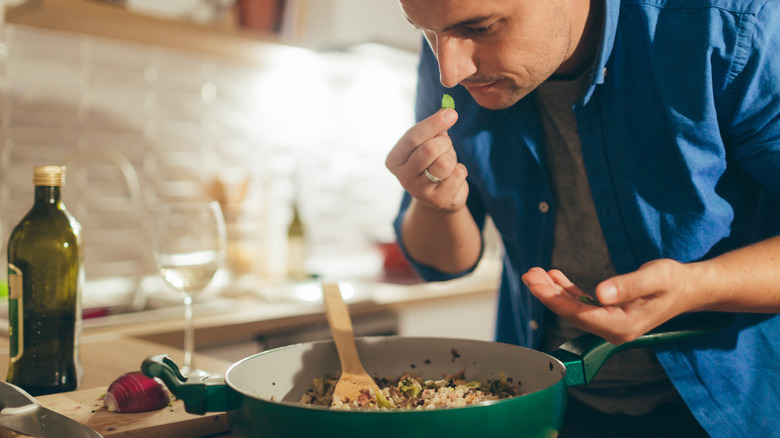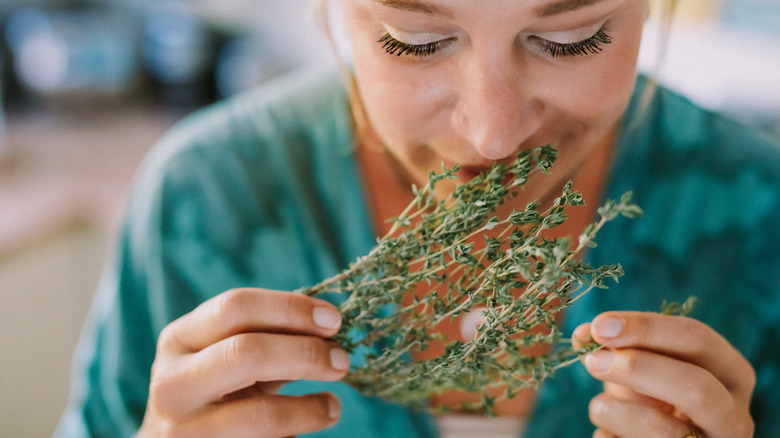Give Seasonings A Sniff To Save Yourself From Major Flavor Disappointment
You hear it from chefs all the time: taste your food as you cook. But that can be hard when you're trying to figure out which seasonings and dried herbs you want to add to your dish. How do you taste those before they've been added to your food? For one, don't. Use your nose instead.
Taste and smell receptors are linked. Much of what you can smell, you can taste. This is also the reason why you can't taste your food when you have a stuffy nose. In a kitchen with a simmering sauce, you can smell the garlic, onions, and tomatoes. So, when you open your spice jars, stick your nose in them. Dried basil and thyme might sing with the aromas in the air. Dried mint might not. Your nose can guide you with your seasonings before you add them in and realize it was a major mistake.
Be nosy with your seasoning
When ingredients begin cooking, they start breaking down and releasing aromas. Onions sautéing in butter is probably one of the best scents in the world. These aromas are roadmaps to which seasoning can be added to a dish.
Let's say you're making a chicken pot pie. You can smell the sweet onions, celery, carrots, and garlic simmering in butter and stock. Now, you must decide on the seasoning. Stick your nose into jars of dried herbs. What do you smell? Is there a spicy note from thyme? An earthy note from sage? Now, smell the air with the chicken pot pie aromas. The scents are harmonious with the herbs, and they will work with the dish. Now, sniff a jar of sumac, a sharp, sweet and sour spice made from dried berries. Even though the spice is delicious, it won't match the aromas of the pot pie, and therefore, won't work in the dish.
Of course, this method isn't foolproof. It's important to note that not all herbs smell pleasant, but that does not mean they don't taste great. Dried tarragon and mustard can have an almost oily coconut smell. But used as a rub on root vegetables for roasting, the herbs add a savory and umami depth. Dried seaweed, which has a powerful mushroom-like scent, can add a delicate sweetness when cooked in a broth. Fresh garlic smells funky — hello, garlic breath — but is the most delicious when cooked. Know that your herbs and seasonings transform with heat, and you'll be able to smell the difference.
Training your nose
Stop and smell the roses. No, we mean it — smell everything. Wine professionals go through major training sniffing through many different glasses of wine and noting everything they smell from fresh fruit to wet rocks. They do this before they taste the wine. This helps tune their sense of smell along with their palate. It's a good exercise for anyone – smell all your ingredients, including your seasonings.
Try this test: sniff a dried herb next to a fresh one. Fresh rosemary will have an aromatic green and floral note. Dried rosemary, with exaggerated green and woodsy notes, will be much more pungent. This is because the oils in the herb become concentrated in the drying process. Adding dried rosemary to a simmering sauce will have a stronger flavor than adding an equal amount of fresh rosemary.
Taste and smell, both are key in finding a good balance in your food. Smell when something is fresh, smell when something is burning. Your nose will sound the alarm when something is awry or take in the scent when something is delicious. Learn to trust it when picking a seasoning for your food.


